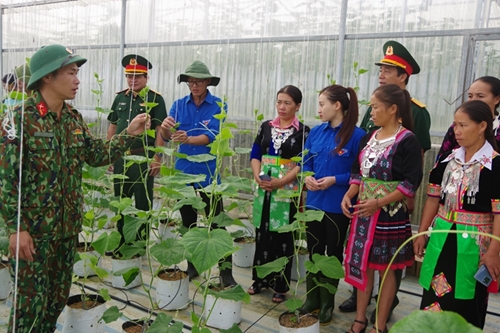When visiting border districts of Nghe An, we noticed significant improvements in local infrastructure, particularly the transportation network. Previously challenging border roads have been renovated and paved, facilitating travel, economic development, and national sovereignty protection. These roads have enabled residents to actively engage in economic activities and helped connect with other regions. Along many routes, communities have formed into small market towns near the border, such as the ring road in Muong Tip commune, Ky Son district. This provides a foundation for developing production models, thereby stabilizing the livelihoods of ethnic minority groups.
    |
 |
|
Instructing local people on how to grow vegetable |
One key initiative for border protection and regional development is the twinning program between villages along the Vietnam-Laos border. Since 2013, Nghe An province has implemented a directive to foster village-to-village partnerships between border communities of both countries. This movement not only strengthens ties between the two nations, but also raises the awareness of territorial sovereignty and border security. Twinned villages regularly hold sessions to educate residents about border-related legal regulations, thereby reinforcing solidarity, friendship, and strong border protection.
Over the past time, border protection forces of Vietnam and Laos have worked closely in patrolling and safeguarding the border. Regular patrols and inspections of the border marker system and national boundary posts helped ensure stability and safety for both sides. This cooperation mechanism has enabled timely resolution of violations, fostering border areas of peace and development.
Thanks to support from economic development and poverty reduction programs, the lives of residents in border areas of Nghe An have improved significantly. The story of Gia Tong Thu, a farmer in Buoc Mu 2 village, Na Ngai commune, Ky Son district, is a prime example. His family received 100kg of taro seed and farming guidance from Defense-Economic Unit 4 under Military Region 4. In the first season, the harvest reached nearly 10 tons. With a selling price of VND 3,500-4,000/kg, his family gained a stable income, greatly improving their quality of life.
Defense-Economic Unit 4 has implemented numerous projects to support agricultural and livestock development for residents. Models such as growing shan tuyet tea, arrowroot, ginger, and passion fruit, as well as raising cattle, goats, and pigs, have helped border communities secure stable incomes and reduce poverty. These initiatives not only improve the livelihood of residents, but also establish effective production models, making significant contribution to regional economic development.
Lieutenant Colonel Nguyen Trung Kien, Commanding Officer of Na Ngai Border Post under the Nghe An provincial Border Guard Command, shared that, despite facing many challenges in their own lives, officers and soldiers of the unit have exemplified the spirit of mutual support, contributing part of their salaries to assist households struggling in economic development. Effective methods, such as providing livestock and crop seedlings and sending officers directly to households to guide them in farming and animal husbandry techniques have been implemented. This initial support has improved many families’ living standards.
With the determined efforts of the entire political system and the support of the armed forces, the border area in Nghe An province is becoming a stable and sustainably developing place. Achievements in border protection, economic development, and social security are solid steps forward for this region to continue to develop and build the shared borderline of peace, friendship, and prosperity.
Translated by Chung Anh